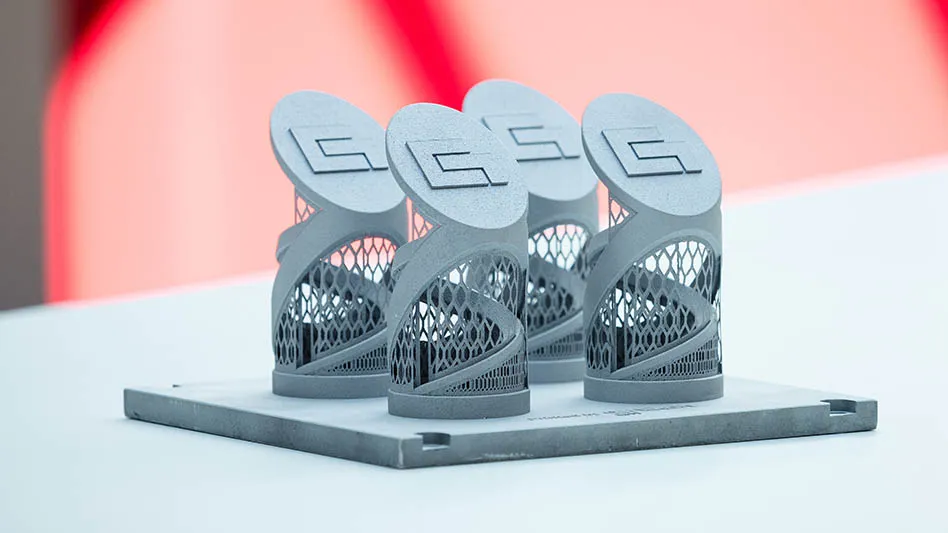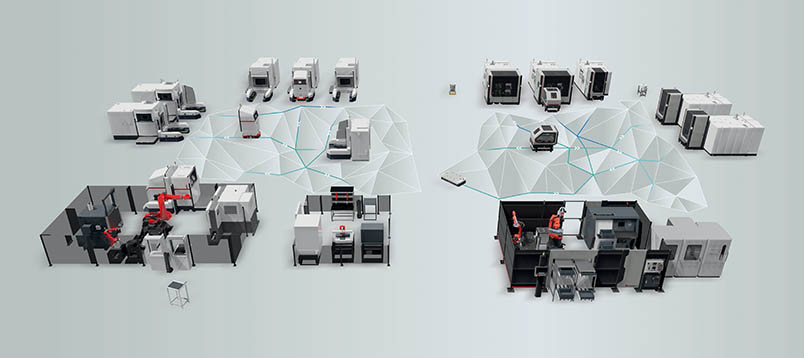
Image courtesy Grenzebach
Evolving from prototype and small-batch production to series production of plastic and metal parts in additive manufacturing (AM) increases efficient utilization of 3D printing equipment, provides a safe working environment, and creates an optimal production flow.
Achieving efficient series production, however, requires intelligent automation and networking capable of perfectly integrating long production times of components in 3D printing with shorter upstream and downstream steps.
Additive Manufacturing (AM), or 3D printing, is the manufacturing of a three-dimensional object from a CAD model or a digital 3D model. It can be done in a variety of processes in which material is deposited, joined, or solidified under computer control with material being added together (such as plastics, liquids, or powder grains), typically layer by layer.
Thirty-five years ago, 3D printing techniques were considered suitable only to produce functional or aesthetic prototypes. As of the past several years, however, the precision, repeatability, and material range of additive manufacturing has increased to where it is now a viable industrial-production technology.
Benefits of AM
Because AM is a material joining process, whereby a product can be directly fabricated from its 3D model, it delivers considerable advantages compared to traditional manufacturing technologies such as CNC machining or casting. AM processes enable the fabrication of parts with a complex shape as well as complex material distribution, and significantly enlarge the design freedom for designers.
a) Complex topology optimized shapes are difficult to handle for CNC machining. To solve this issue, AM processes can be applied to fabricate topology optimized parts – a technique which can optimize material layout within a given design space. Compared to size optimization or shape optimization, topology optimization can update both shape and topology of a part.
b) Due to the unique capabilities of AM processes, parts with multiscale complexities can be realized. This provides a great design freedom for designers to use cellular structures or lattice structures for the preferred properties. In aerospace, lattice structures fabricated by AM can be used for weight reduction. Previously difficult to manufacture, lattice structures have high strength and low mass mechanical properties and multifunctionality.
c) Parts with multi-material or complex material distribution can be achieved by AM processes using a single printer.
d) Since AM can directly fabricate parts from digital models, it significantly reduces the cost and lead time of producing customized products.
e) Given the constraints of traditional manufacturing methods, some complex components are usually separated into several parts for ease of manufacturing and assembly. This situation has changed, where component parts of an original design can be consolidated into one complex part and fabricated by AM processes.
Need for 3D series production
The challenge with AM is the long production time required for each item in the 3D printer, whereas upstream and downstream production steps have significantly shorter lead times. This makes for considerable inefficiencies in the overall AM process.
The solution is series production, with intelligent automation and network integration of all upstream and downstream processes in the 3D printing cycle. Users benefit from automated processes, while ensuring optimum material flow between individual devices such as printers, depowdering, and finishing systems. In addition to increasing efficient utilization of the 3D printing equipment, automated production provides a safe working environment for workers.
Improved efficiency
Automation intelligently and reliably networks process steps with different throughput times. 3D printing, pre-processing, and post-processing systems are mechanically, electronically, and digitally synchronized, resulting in optimally utilized machinery with maximum output.
Lower cost per part
Intelligent networking of the individual working steps allows maximum use of all systems. This enables production with lower costs per part.
Occupational health and safety
During the post-processing of 3D-printed components, there may be health risks due to fine dust and nanoparticles. Optimally designed automation solutions comply with occupational health and safety regulations and reduce risks for workers.
Industrial 3D printing intelligently synchronized
Multiple process steps of varying duration make AM a complex matter. Each manufacturer has specific requirements for type of material being used for 3D printing, preprocess and postprocess procedures. To prepare a sequence of 3D printing functions for streamlined serial production requires addressing the automation components for each process.

Reviewing the procedures of a company well versed in automation for series production with AM would be beneficial to gain a more practical understanding. One such company is Grenzebach – a global automation solutions provider with more than 60 years of experience in the automation of complex processes for a wide spectrum of industries.
Grenzebach delivers holistic automation solutions for series production of powder bed-based AM for metal and polymer, including upstream and downstream process steps. The company is a pioneer in developing manufacturing-specific solutions for everything that is needed for intelligent series production with AM. This includes automated guided vehicles (AGVs), robot cells, gripping technology, inspection systems, and networking all process steps for communication and data exchange.

Following is a breakdown of automated system solutions that support intelligent synchronization of series production for AM. These systems cover loading and unloading, AM, depowdering, and postprocessing:
Robot cells – for gripping parts, build boxes, and build plates. Gripping of individual components or containers, e.g. small load carriers (KLT containers), unpacking of build plates or inspection of the produced parts. Execution of the full spectrum of stand-alone solutions up to the 7th axis, with integration of robotics.
Transportation and conveying equipment – includes stationary conveyors, and semi-automated or fully-automated transport, like AGVs, for individual movement of build boxes and load carriers. AGVs that are well adapted for this application – like the Grenzebach models L1200S and OL1200S – help make processes more flexible in the long term. Depending on the need, suitable goods carriers can be used open or closed (with/without inert gas).
Machine fitting – includes the development, design, and manufacturing of docking frames or extensions of existing equipment, as well as mechanical and electrical connection of machines. This also encompasses ports or attachments to enable a safe, efficient, and fully automated process for loading/unloading of the machine.
Inspection – the quality of produced components is inspected via 2D/3D image processing systems, inline within the process chain, including part recognition and sorting. This is possible both inline on the conveyor and via robot-guided inspection systems.
Software integration – incorporates horizontal and vertical communication for all process steps and data exchange by OPC UA interface or hard wired.
Automotive and aerospace manufacturing
Additive manufacturing opens up new perspectives for so many industries, but the automotive and aerospace industries have been early embracers of this critically important technology. To produce components, these industries are increasingly capitalizing on the possibilities of AM.
Vehicles and aircraft can be designed with fewer components but with enhanced functionalities and lower overall weight.
Intelligent automation and networking are required for safe, efficient series production of components by 3D printing. In particular, the synchronization of production steps and transport between manufacturing cells, as demonstrated in series production, is immensely important. Good capacity utilization is key. Only in this way can the equipment be used optimally with long production times of a build job in the printer and significantly shorter throughput times of upstream and downstream production steps.
Assessing the right AM process
Because so many factors can impact AM processes, it is important for manufacturers to consult an experienced 3D printing automation expert who knows the specifics and priorities influencing series production relative to their application.
This is necessary for analysis of requirements and optimum concept development, to ensure the smooth integration into the production environment, including the integration of existing machines into the process chain.
Automation experts help manufacturers develop solutions to facilitate achieving the desired production throughput and process control, while ensuring maximally efficient use of 3D printing equipment.
About Grenzebach Group
Grenzebach is a specialist in handling and processing technology and in the automation of additive manufacturing and robotic handling applications.
About the author: Oliver Elbert is head of additive manufacturing, Grenzebach Group. For more information, contact Andrea Steigerwald, head of corporate marketing & communications:
andrea.steigerwald@grenzebach.com.
Latest from Aerospace Manufacturing and Design
- Upcoming webinar to highlight the rise of electric vehicles
- JEKTA, ZeroAvia partner on hydrogen-electric amphibious aircraft
- Mastercam 2025 software
- IMTS 2024 Conference: Cutting Edge Innovations: Maximizing Productivity and Best Practices with Superabrasives
- Eve Air Mobility unveils first full-scale eVTOL prototype
- Dillon Manufacturing's Fast-Trac Jaw Nuts
- IMTS 2024 Conference: Breaking the Tradeoff: Utilizing Deep Learning AI with X-ray Computed Tomography for Unparalleled Clarity and Speed
- #47 - Manufacturing Matters - The Ins and Outs of CMMC 2.0 with Smithers Information Security Services





